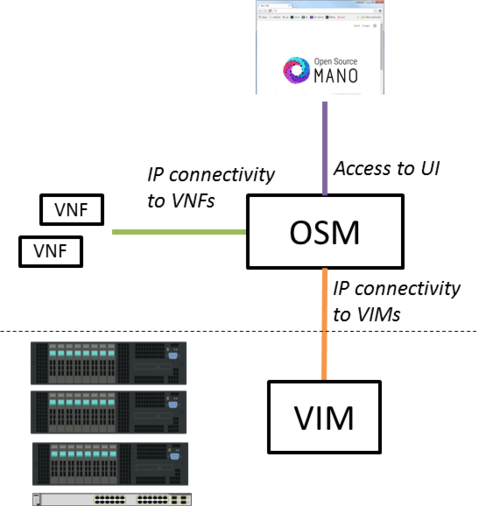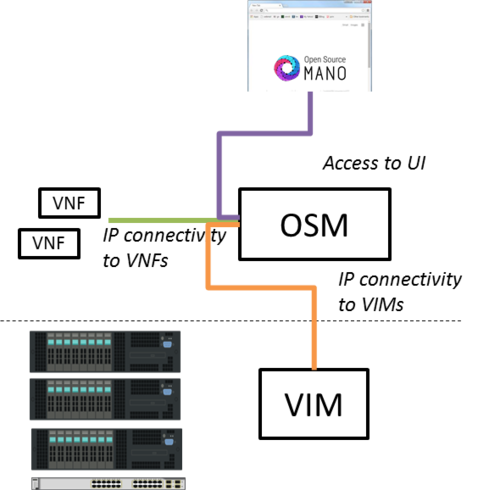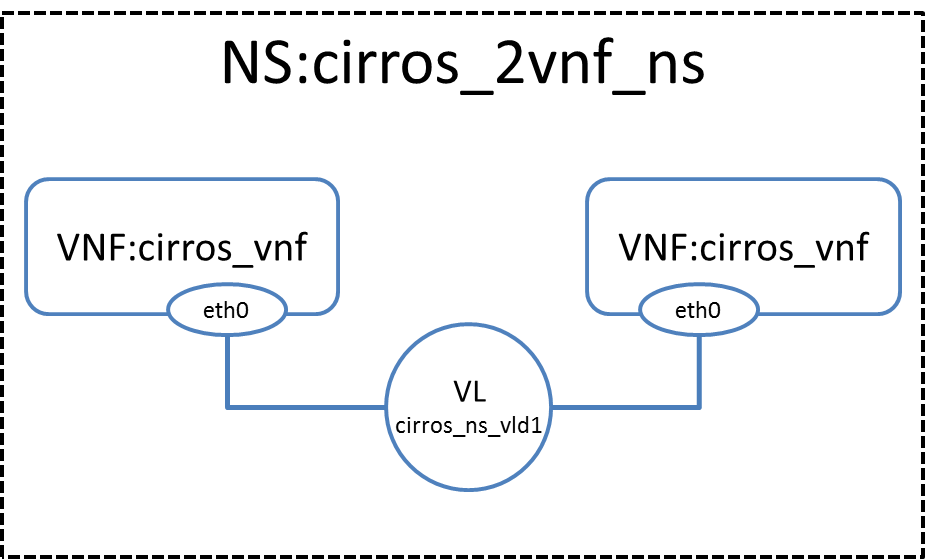Talk:OSM Release ONE
OSM is an open source project offering an Open Source NFV Management and Orchestration (MANO) software stack aligned with ETSI NFV.
The following figure shows OSM interaction with VIM and VNFs.

Obviously, OSM can use a single interface for interacting with VIMs and VNFs.

Install OSM
Install from source
All you need to run OSM Release One is a single server or VM with the following requirements:
- 8 CPUs, 16 GB RAM, 100GB disk and a single interface with Internet access
- Ubuntu16.04 as base image, configured to run LXD containers. If you don't have LXD configured, you can follow the instructions here (LXD configuration)
Once you have prepared the host with the previous requirements, all you need to do is:
wget https://osm-download.etsi.org/ftp/osm-1.0-one/install_from_source.sh chmod +x install_from_source.sh ./install_from_source.sh
After some time, you will get a fresh OSM Release One installation. You can access to the UI in the following URL (user:admin, password: admin):
https://your_local_ip:8443
Adding a VIM account
Before proceeding, make sure that you have a VIM configured to run with OSM. Three different kinds of VIMs are currently supported by OSM:
- OpenVIM
- OpenStack
- VMware vCloud Director
The following instructions are required to be executed in the host to add the datacenter, depending on the DC type:
- OpenVIM DC (e.g. IP address: 10.10.10.10, VIM tenant "osm")
lxc exec RO --env OPENMANO_TENANT=osm -- openmano datacenter-create openvim-site http://10.10.10.10:9080/openvim --type openvim --description "Openvim Datacenter" lxc exec RO --env OPENMANO_TENANT=osm -- openmano datacenter-attach openvim-site --vim-tenant-name=osm lxc exec RO --env OPENMANO_TENANT=osm -- openmano datacenter-list
- OpenStack DC (e.g. IP address: 10.10.10.11, VIM tenant "admin", user "admin", password "userpwd")
lxc exec RO --env OPENMANO_TENANT=osm -- openmano datacenter-create openstack-site http://10.10.10.11:5000/v2.0 --type openstack --description "OpenStack Datacenter" lxc exec RO --env OPENMANO_TENANT=osm -- openmano datacenter-attach openstack-site --user=admin --password=userpwd --vim-tenant-name=admin lxc exec RO --env OPENMANO_TENANT=osm -- openmano datacenter-list
- VMware DC (e.g. IP address: 10.10.10.12, VIM tenant "vmware-tenant", user "osm", password "osm4u", admin user "admin", admin password "adminpwd")
lxc exec RO --env OPENMANO_TENANT=osm -- openmano datacenter-create vmware-site https://10.10.10.12" --type vmware --description "VMware Datacenter" --config '{admin_password: adminpwd, admin_username: admin}' lxc exec RO --env OPENMANO_TENANT=osm -- openmano datacenter-attach vmware-site --user=osm --password=osm4u --vim-tenant-name=vmware-tenant lxc exec RO --env OPENMANO_TENANT=osm -- openmano datacenter-list
Note: The name of the datacenter "vmware-site" has to match the name of the organization of "vCloud Director". Inside this organization the tenant "vmware-tenant" must exist
Deploying your first Network Service
In this example we will deploy the following Network Service, consisting of two simple VNFs based on CirrOS connected by a simple VLD.
Before going on, download the required VNF and NS packages from this URL: https://osm-download.etsi.org/ftp/examples/cirros_2vnf_ns/
Uploading VNF image to the VIM
- Get the cirros 0.3.4 image from the following link: http://download.cirros-cloud.net/0.3.4/cirros-0.3.4-x86_64-disk.img
- Onboard the image into the VIM. The instruction differs from one VIM to another:
- In Openstack:
openstack image create --file="./cirros-0.3.4-x86_64-disk.img" --container-format=bare --disk-format=qcow2 --public --property location="/mnt/powervault/virtualization/osm/CirrOS/cirros-0.3.4-x86_64-disk.img" cirros034
- In openvim:
openvim image-create --name cirros034 --path /mnt/powervault/virtualization/osm/CirrOS/cirros-0.3.4-x86_64-disk.img
Onboarding a VNF
- Access to the UI, click on the catalog, click on the import button, drag the file cirros_vnf.tar.gz and drop it in the bottom-left panel.
Onboarding a NS
- Access to the UI, click on the catalog, click on the import button, drag the file cirros_2vnf_ns.tar.gz and drop it in the bottom-left panel.
Instantiating the NS
- Access to the UI, click on Instance...
Wait for the message that the NS has been successfully deployed, and that's all!!!
